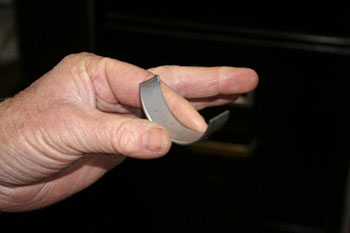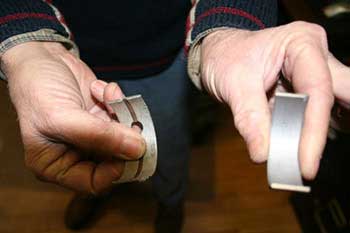TS Imported Automotive Tech Tips
The Tech Tips section is a collection of useful technical information that TS Imported Automotive would like to share with everyone. The tips range from useful tools, hints on how to handle parts, and information on how to work on your vehicle safely. We will be adding new tips every once in a while, so check back often.
Tip #1: How to Handle an Engine Bearing


Tip #2: Tire Pressure
Tire Pressure!! Just because they do not look flat does not mean they are properly inflated. Low air pressure could result in decreased performance, uneven tread wear and even lower mpg. Be sure to double check your psi once a week.
Tip #3: Do's & Don'ts of Flat Tappet Cam Break In!
Don't
use synthetic oil for break in of a new engine. It is too slippery to
allow components, such as rings, to seat. If rings don't seat,
they will always leak - NOT GOOD.
Do use cam lube specified by
the cam manufacturer. If this is not given, use a good
quality moly pre-lube paste on lifters and cam lobes.
Don't
pump up hydraulics lifters - TR8, Rover V8, etc. -before use. This
could cause the lifter to keep a valve open so new engine will be hard
to start.
Do prime the engine oil system by manually operating
the oil pump or pressure filling the system with a pressurized oil
tank. Be sure to lubricate the lifter walls and pushrods with
engine oil.
Don't use the starter to spin over the new engine in an attempt to buildup oil pressure.
Do
idle a new engine tart-up between 2000 - 3000 rpm. Vary the idle
speed up and down and run for 20 -25 minutes. The first 30 seconds and
the first 5 minutes determine cam success.
Tip #4: A simple way to test valve spring condition!
You can test valve spring condtion of a used spring by a simple comparison test with a new spring. Put the used and new spring, end to end in a vise with a piece of flat steel stock, such as 1/16" strap between the two springs. Using a steel pocket measure or similar acurate measuring device, start to slowly close the vise. Watch the two springs and keep measuring spring length. If your original spring starts to compress before the new spring, your old spring has lost some of its strength. Time to replace the valve springs.
Tip #5: If you use Vise Grips to remove a number of items, such as valve seals, that require the same clamping pressure, try this. Remove the adjusting screw from the Vise Gripsand replace it with a bolt and nut. Set the pliers to the desired tension/pressure, then run the nut down against the handle. Now you will not have to readjust the presssure for repetitive operations.